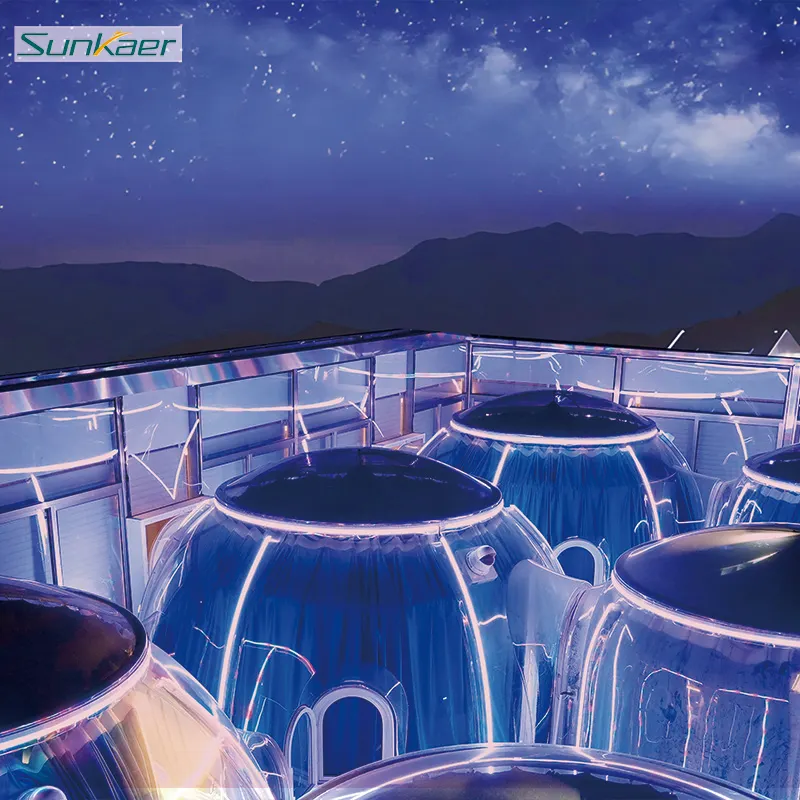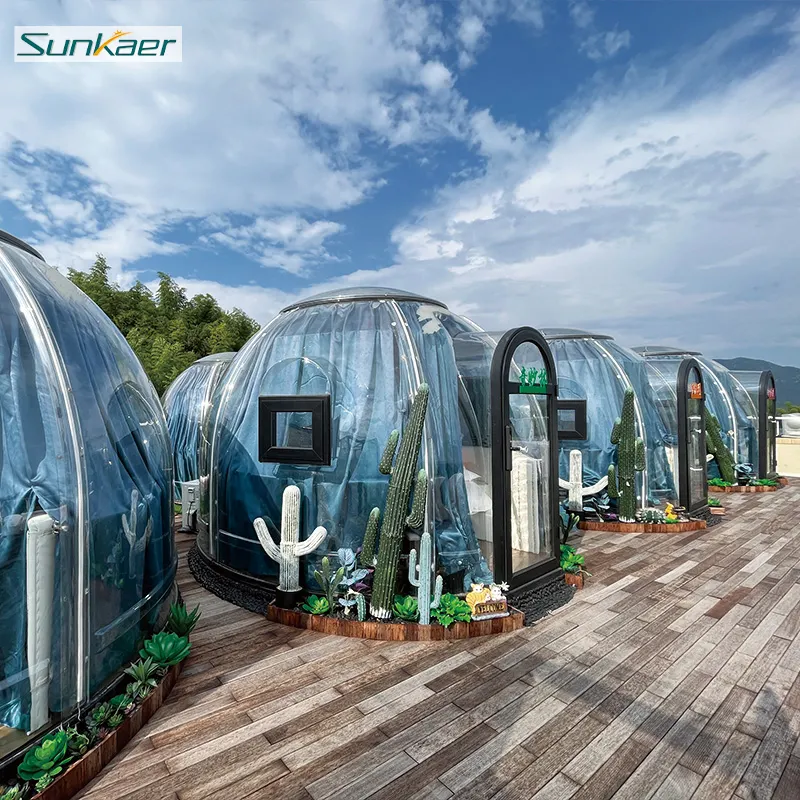A new chapter in hospitality architecture
Dome houses combine striking visual identity with deeply practical advantages, making them uniquely suited for catering and accommodation venues. The curved geometry creates generous, column-free interiors that feel both expansive and intimate, while the shell form delivers exceptional structural resilience and energy performance. Operators who adopt dome houses benefit from faster builds, flexible programming, lower operating costs, and a memorable guest experience that drives bookings and word-of-mouth. Below I unpack the reasons dome houses work so well for venues and how you can plan, build, and operate them to maximize return and guest delight.
Design and structural advantages of dome houses
Open-plan interiors and flexible layouts
Dome houses naturally produce large, uninterrupted internal volumes because their shell handles structural loads. For catering and accommodation venues this translates to enormous versatility. A single dome house can be set up for a breakfast banquet in the morning, a conference or tasting event by day, and intimate lodge-style accommodation by night without moving walls or heavy infrastructure. Furniture, lighting and service lines can be reconfigured quickly to suit the program, and event crews appreciate the freedom to design immersive guest flows without structural restrictions.
This flexibility reduces turnaround time between events and multiplies the utility of a single footprint. Venues can therefore generate more revenue per square meter by switching uses across the day or season. For pop-up festivals, seasonal lodges, or multi-use hospitality compounds, dome houses offer unmatched adaptability.
Structural resilience and long service life
The geometry of dome houses distributes stress evenly across the shell, which makes them inherently strong against wind, snow loads and seismic forces. As a result, dome houses withstand weather extremes better than many conventional framed structures. For event operators who host outdoor-adjacent programs or run hospitality ventures in exposed locations, that reliability reduces downtime risk and insurance premiums.
The durable shell also lowers ongoing repair needs. Paint, cladding or membrane replacements are less frequent than maintenance on complex framed roofs and eaves. Over a venue’s lifecycle the lower maintenance burden improves profitability and simplifies facilities management for operators focused on guest experience rather than building upkeep.
Material efficiency and simplified assemblies
Compared with rectilinear buildings of similar volume, dome houses generally use fewer construction materials to achieve the same enclosed volume. The geometry reduces surface area relative to volume, which is one reason many operators find the life-cycle environmental and cost balance favorable. Modern prefabrication techniques and modular dome kits accelerate on-site assembly and reduce waste; panels, ribs or shell segments arrive ready to fit and can be installed with smaller crews.
Faster assembly times matter for hospitality entrepreneurs who want to open quickly or to test a concept with low site disruption. Whether you plan a permanent boutique resort or a seasonal event village, dome houses dramatically shorten the lead time between purchase and guest revenue.
Comfort and climate performance in dome houses
Natural airflow and thermal comfort
Dome houses benefit from improved internal convection compared with boxy rooms. Warm air rises naturally and mixes evenly, reducing hot and cold pockets that force heavy HVAC loads. This natural circulation, combined with modern insulation materials, leads to consistent comfort for guests and lower energy consumption over time.
Careful detailing — insulated shell panels, airtight joinery, and quality glazing — transforms dome houses into low-energy spaces. For accommodation venues where guests demand quiet, comfortable nights, the thermal stability of dome houses is a genuine selling point.
Passive design strategies for energy savings
Dome houses lend themselves to passive heating and cooling strategies: optimizing orientation for winter solar gain, shading for summer, and leveraging thermal mass where appropriate. When operators pair these passive measures with efficient mechanical systems, energy bills drop and the venue’s carbon footprint improves—important for guests who choose ecotourism or sustainability-focused stays.
Lower operating energy also makes dome houses attractive for remote or off-grid hospitality where fuel or electricity costs are high. With fewer mechanical demands, venues can prioritize guest amenities and experiences rather than extensive building services.
Guest experience and atmosphere in dome houses
Strong emotional and marketing appeal
There’s an immediate emotional response to dome houses: their form signals uniqueness and intentional design. Guests remember stays in dome houses because the space feels different from standard rooms. That memorability translates into higher social sharing, better trip-advisor reviews and repeat bookings — all vital marketing channels for boutique hospitality.
From a brand perspective, dome houses enable a clear narrative: immersive escapes, design-led hospitality, and closeness to nature. Venues that position dome houses as the centrepiece of a curated guest experience can command premium rates and cultivate loyal audiences.
Day–night programming that maximizes guest value
Because dome houses perform well as both event spaces and accommodation, they allow venues to squeeze more value from each asset. A dome can host a daytime culinary class, an evening private dining event, and late-night guests in the same shell. This continuous programming increases revenue potential per dome house while offering guests multiple forms of engagement with the same distinctive setting.
Couple the architecture with well-designed services — lighting scenes, acoustic control, and layered amenities — and dome houses become the venue’s most flexible product.

Construction, installation and operational efficiency
Prefabrication, logistics and build speed
Many dome house systems are designed for prefabrication: panels, ribs or segmented shells are manufactured off-site and assembled quickly on location. This approach reduces site waste, improves quality control, and accelerates schedule. For venue operators this means lower disruption, predictable timelines and earlier guest intake.
Well-designed prefabricated systems also simplify labor requirements and allow smaller installation teams. If the venue is in a remote setting, modular domes reduce the need for heavy on-site fabrication and minimize site impact.
Simplified maintenance and lifecycle savings
Dome houses typically have fewer joints, eaves and flat surfaces that trap water or debris. The continuous shell sheds rain and snow efficiently, reducing leak points and exterior maintenance. Over the building’s life this can translate into substantial cost savings: less frequent repairs, longer intervals between repainting or membrane replacement, and reduced maintenance staffing needs.
Lower lifecycle costs — combined with strong guest demand for unique stays — make dome houses economically appealing for operators evaluating total cost of ownership rather than just upfront capital cost.
Programming, operations and venue models with dome houses
Multi-use resort clusters and modular villages
Dome houses perform well as elements in a larger hospitality ecosystem. A cluster of domes can support diverse activities: communal dining domes, private guest domes, spa or wellness domes, and staff/utility domes. This modularity supports phased growth: start with a few guest domes and expand as demand grows, keeping capital risk manageable.
Operators can design themed circuits (wellness, culinary, adventure) where each dome contributes a unique experience. This creates packages that extend guest stays and increase per-visitor spend.
Seasonal pop-ups and permanent installations
Because dome houses are fast to install and can be made relocatable, they work equally well for seasonal pop-ups — such as winter dining domes or festival accommodations — and for permanent boutique resorts. The same physical asset can be redeployed or reprogrammed, offering operational flexibility that conventional construction cannot match.
This mobility is particularly valuable when testing a new market or concept: the lower commitment required to trial a site reduces exposure while proving the model.
Sustainability and resource considerations for dome houses
Reduced material use and waste
The efficient geometry of dome houses often requires less external surface area for a given internal volume, which can reduce insulation, roofing and cladding material needs. When combined with prefabrication and off-site manufacturing, on-site waste is minimized and material sourcing becomes more controlled.
For sustainability-minded guests and operators, this lower resource profile supports responsible branding and can form part of a venue’s sustainability story.
Opportunities for green systems and certifications
Dome houses integrate well with renewable energy systems (PV arrays, small wind) and water-saving measures (rainwater capture, greywater recycling), enabling off-grid or low-impact operations. These synergies help venues pursue eco-certifications or sustainability ratings that attract guests seeking environmentally conscious travel.
Practical considerations when choosing dome houses for your venue
Site analysis and microclimate matching
A successful dome house deployment begins with careful site selection. Analyze wind patterns, solar orientation, drainage and views. Dome houses excel on sloped or irregular sites where conventional foundations are costly; their small footprint and efficient form often reduce earthworks.
Matching microclimate to dome design — selecting glazing, insulation and ventilation strategies tailored to local conditions — ensures comfort and energy savings in operation.
Design for serviceability and guest flow
Designers and operators should plan service lines, waste handling, laundry and staff access as early as guest amenities. Even with open interiors, dome houses require well-thought routing for plumbing, electrical and catering services so events and accommodation run smoothly.
Good design keeps back-of-house functions discreet while preserving the immersive guest environment that is the dome house’s central appeal.
Incorporating manufacturer and supply expertise into your project
When sourcing dome houses, prefer manufacturers with broad experience in prefabrication, local installation guidance and after-sales support. Experienced suppliers often provide full-package services: customization, 3D site design, factory-produced components, installation manuals and field support. That end-to-end capability shortens lead times, reduces on-site risk, and helps venues launch with confidence.
An experienced supplier network also usually offers multiple dome configurations (fixed round, sliding round, oval fixed, oval sliding) so you can match the dome house type to the venue’s weather conditions and operational needs.
Financial model and return considerations for dome houses
Upfront investment versus life-cycle cost
Although initial capital for a quality dome house may be similar to or sometimes slightly higher than simple framed construction, the total life-cycle cost often favors the dome solution. Savings from reduced energy bills, lower maintenance, faster time-to-revenue and better marketing traction typically lead to competitive returns over a 5–10 year horizon.
Operators should model scenarios that include occupancy uplift due to distinctive accommodation, variable event income, and energy savings to get a realistic ROI view.
Revenue diversification enabled by dome houses
Dome houses allow venues to diversify revenue: overnight stays, daytime events, weddings, seasonal dining domes, workshops, and retreats. This multi-channel revenue capability smooths seasonality, improves asset utilization and strengthens financial resilience.
Implementation checklist for operators planning dome houses
Confirm objectives and guest experience goals
Define whether domes are primarily for accommodation, high-end dining, events, wellness retreats, or a mix. That decision shapes size, finishes, glazing and service requirements.
Secure manufacturer support and site design
Work with a supplier that offers design collaboration, prefabrication options, installation guidance and warranty support. Request sample 3D designs and site plans to visualize guest flow and back-of-house logistics.
Plan for operations and lifecycle maintenance
Budget for periodic shell inspections, replaceable cladding elements, and service access. Establish maintenance protocols that maximize life-span and guest safety.
FAQ
Are dome houses safe and suitable for guest accommodation
Dome houses are structurally robust and well suited for hospitality uses when specified and installed correctly. Their shell form spreads loads evenly, making them resilient to wind, snow and seismic conditions. Proper detailing and quality installation ensure safety and long service life.
Will dome houses reduce my venue’s energy costs
Yes. Dome houses tend to perform very efficiently in terms of heating and cooling because of reduced surface area and improved internal airflow. When combined with good insulation and passive design strategies, energy savings can be substantial and predictable.
Can a single dome house operate as both event space and accommodation
Absolutely. The open interior of dome houses enables quick reconfiguration: setting up dining, staging, or lodging uses within the same shell. Thoughtful furniture systems, lighting scenes and service planning make transitions smooth and maximize revenue potential.
How do I find a reliable supplier for dome houses and on-site support
Select suppliers who provide end-to-end support: custom design, prefabrication, 3D site modeling, installation guidance and after-sales warranty. Suppliers with documented field experience and multiple dome configurations will reduce risks and speed up deployment.
Table of Contents
- A new chapter in hospitality architecture
- Design and structural advantages of dome houses
- Comfort and climate performance in dome houses
- Guest experience and atmosphere in dome houses
- Construction, installation and operational efficiency
- Programming, operations and venue models with dome houses
- Sustainability and resource considerations for dome houses
- Practical considerations when choosing dome houses for your venue
- Incorporating manufacturer and supply expertise into your project
- Financial model and return considerations for dome houses
- Implementation checklist for operators planning dome houses
- FAQ

